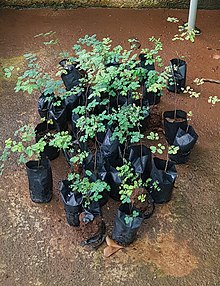Libidibia coriaria
| Divi-divi | |
|---|---|

| |
| Divi-divi on Aruba | |
| Scientific classification | |
| Kingdom: | Plantae |
| Clade: | Tracheophytes |
| Clade: | Angiosperms |
| Clade: | Eudicots |
| Clade: | Rosids |
| Order: | Fabales |
| Family: | Fabaceae |
| Genus: | Libidibia |
| Species: | L. coriaria
|
| Binomial name | |
| Libidibia coriaria | |
| Synonyms[1] | |
| |
Libidibia coriaria, synonym Caesalpinia coriaria, is a leguminous tree or large shrub native to the Caribbean, Central America, Mexico, and northern and western South America.[1] Common names include divi-divi, cascalote, guaracabuya, guatapana, nacascol,[2] and watapana (Aruba).
Description[]



L. coriaria rarely reaches its maximum height of 9 m (30 ft) because its growth is contorted by the trade winds that batter the exposed coastal sites where it often grows. In other environments it grows into a low dome shape with a clear sub canopy space. Leaves are bipinnate, with 5–10 pairs of pinnae, each pinna with 15–25 pairs of leaflets; the individual leaflets are 7 mm long and 2 mm broad. The fruit is a twisted pod 5 cm (2.0 in) long.
Taxonomy[]
The species was first described by Nikolaus Joseph von Jacquin in 1763, as Poinciana coriaria. In 1799, Carl Ludwig Willdenow transferred it to the genus Caesalpinia, and in 1830, Diederich von Schlechtendal transferred it to his newly created genus Libidibia.[3] The genus Libidibia was not always accepted and the species was usually placed in Caesalpinia, until molecular phylogenetic studies led to the reinstatement of Libidibia.[4]
Chemistry[]
Tannins are extracted from divi-divi pods for use in leather production.[5][6]
Among the molecules isolated is corilagin, whose name comes from the specific epithet of the plant.
In culture[]
Divi-divi is the national tree of Curaçao.[7] It is also very common and popular on Aruba.[citation needed]
See also[]
References[]
- ^ Jump up to: a b c "Libidibia coriaria (Jacq.) Schltdl". Plants of the World Online. Royal Botanic Gardens, Kew. Retrieved 2021-06-28.
- ^ " Libidibia coriaria (Jacq.) Schltdl". Germplasm Resources Information Network (GRIN). Agricultural Research Service (ARS), United States Department of Agriculture (USDA). Retrieved 2021-06-28.
- ^ "Poinciana coriaria Jacq". The International Plant Names Index. Retrieved 2021-06-28.
- ^ "Libidibia Schltdl". Plants of the World Online. Royal Botanic Gardens, Kew. Retrieved 2021-06-28.
- ^ "Vegetable tannins". Bookbinding and the Conservation of Books. Conservation OnLine. 2011-03-10. Retrieved 2011-04-18.
- ^ Perez-Tello, Carlos (1995). "Recovery of Vegetable Tannins from Divi-divi Pods". Journal of Chemical Technology & Biotechnology. 64 (1): 101–104. doi:10.1002/jctb.280640116.
- ^ Sullivan, Lynne M. (2006). Adventure Guide to Aruba, Bonaire & Curaçao. Hunter Publishing Inc. p. 10. ISBN 978-1-58843-572-9.
External links[]
 Media related to Libidibia coriaria at Wikimedia Commons
Media related to Libidibia coriaria at Wikimedia Commons Data related to Libidibia coriaria at Wikispecies
Data related to Libidibia coriaria at Wikispecies
- Caesalpinieae
- Plants described in 1799
- Symbols of La Guajira Department
- National symbols of Curaçao
- Trees of the Caribbean
- Trees of Central America
- Trees of Mexico
- Trees of Venezuela
- Trees of Guatemala
- Trees of Colombia